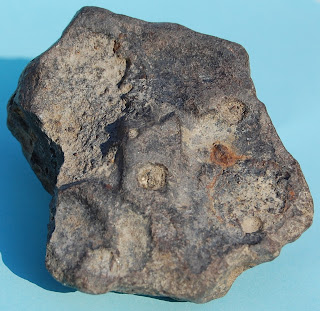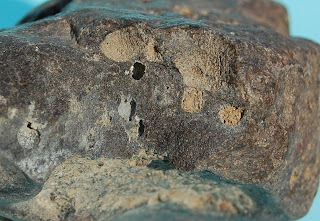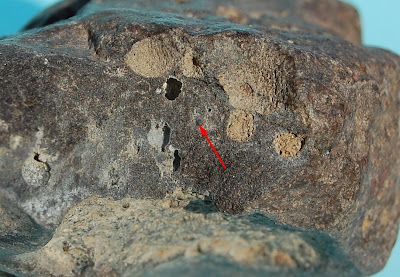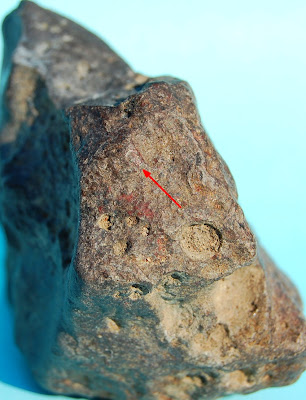Proving myself wrong about a rock
 I've carried this rock around for so many years I've forgotten where I found it. I suspect, though, it was on a trip to San Benito County, California, with a group of fellow Geology students looking at the ultramafic rocks there.
I've carried this rock around for so many years I've forgotten where I found it. I suspect, though, it was on a trip to San Benito County, California, with a group of fellow Geology students looking at the ultramafic rocks there."Ultramafic" refers to rocks with high Magnesium and Iron content; the County is host to a sequence of rocks derived from the upper part of the Mantle during a continental collision.
The connection of this rock with that trip is only in retrospect. Since finding the rock in a box several years ago, I've considered it might be a meteorite, mainly because it is rather heavy and sort of "looks right". Recently I decided to find out.
I decided to first measure its density. I don't have lab equipment available, so I used what I found in the kitchen: a spice scale (capacity 0.5kg) and a 0.5 liter measuring cup. I weighed the stone (210g), then put the stone in the cup and added water until it was covered, turned it all ways with a spoon to knock off all bubbles, then topped it to 500cc, the top line on the cup. I fished out the stone and read "a little below 450", which I estimated as just above 440cc. So the difference was less than 60cc, and I called it 58-to-60cc. Divide these limits into 210, and the result is 3.5-3.6 g/cc. That's in the right range for a stony-iron meteorite.
Checking relative accuracy, I decided I wasn't quite satisfied. The scale is marked each 10g, and can be read to 5g with care, so 210±5 meant a range of ±2.3%. The measuring cup, however, is only marked each 50cc, and it is hard to read a fifth of a marking, particularly because their spacing changes on the tapered cup. Generously assuming I can read to 10cc accurately, I still was faced with a range of ±10cc out of about sixty, or about ±17%. And there's no telling how properly printed the markings are...
So I used weight instead of volume. I tied a thread harness to the rock, so it would hang flat. I put the rock into the cup with enough water to cover it when I lifted it clear of the bottom. The whole rig exceeded the capacity of the scale, but not when I lifted the rock above the bottom of the cup, yet still under the water. I could just make it: 490 grams. Then I lifted the rock all the way out, and the reading dropped to, as nearly as I could tell, between 435cc and 440cc. I split the difference at 52.5±2.5cc, an error figure of ±4.8%. Now we're getting somewhere.
The result was 4.0g/cc, ±5.3%, or a range from 3.8-4.2. The former measurement, 3.55 with a ±17% range, covers a possible span of 2.9-4.2! Anyway, it doesn't contradict the new measurement. Now...what has a density of 4?
Stony meteorites have a density in the range 3.0-3.3. Iron ones are near 8, and even stony-iron ones are typically less than 3.8. My stone is either too heavy or too light to be a meteorite, and is not magnetic, so stony-iron is out. A closer look provides a further clue.
 This broken surface, which is in the shadow to the left of the first photo, shows holes inside the rock.
This broken surface, which is in the shadow to the left of the first photo, shows holes inside the rock.A quick look at the Meteorite Realities page confirmed my suspicion that no meteorite formed with internal holes; there is no gas in space to open the holes, and these are clearly gas bubble holes. Though they appear to constitute only a few percent of the rock, they indicate that the bulk density without porosity ought to be several percent greater, at least 4.2-4.4 g/c. Now I'm in trouble...
 The rounded lump at the arrow is reddish compared to the solidly gray background. Is it a garnet? Perhaps the garnet (or whatever) is one of the denser types, but it has to constitute most of the rock to have much effect. The usual sort of garnet peridotite seldom exceeds a density of 3.5, and this rock isn't green enough to be a peridotite (think the black sands of Hawaii, which are really blackish green, formed of peridot sand).
The rounded lump at the arrow is reddish compared to the solidly gray background. Is it a garnet? Perhaps the garnet (or whatever) is one of the denser types, but it has to constitute most of the rock to have much effect. The usual sort of garnet peridotite seldom exceeds a density of 3.5, and this rock isn't green enough to be a peridotite (think the black sands of Hawaii, which are really blackish green, formed of peridot sand). This image, around the end of the stone from the other two views, shows a squarish, reddish crystal (see the arrow). Maybe a garnet, or possibly a spinel. The reddish stain below gave me another clue, and there are several around the stone (see the first image). Now I remembered that trip to San Benito. I still don't know if that is where I got the rock, because we also visited a number of mines on that trip and later ones during my Senior year as a Geology student.
This image, around the end of the stone from the other two views, shows a squarish, reddish crystal (see the arrow). Maybe a garnet, or possibly a spinel. The reddish stain below gave me another clue, and there are several around the stone (see the first image). Now I remembered that trip to San Benito. I still don't know if that is where I got the rock, because we also visited a number of mines on that trip and later ones during my Senior year as a Geology student.What is clear is that this is a combination of garnet or spinel in a siderite-hematite mix. These occur together in metamorphic assemblages, and both San Benito County and other places I frequented in those years were metamorphic terranes with plenty of sources for iron ore, which is just what this is.



1 comment:
https://hillscloud.wordpress.com/4312-2/
Post a Comment